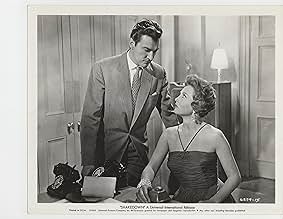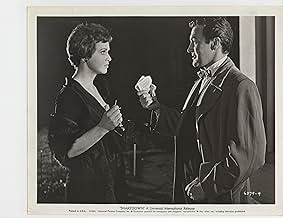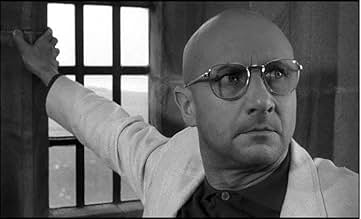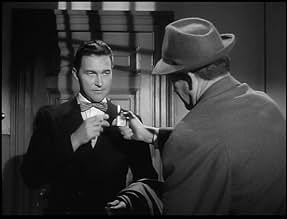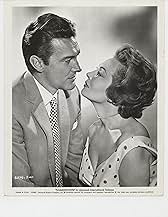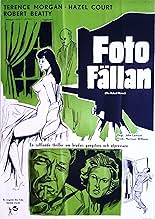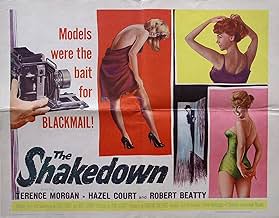VALUTAZIONE IMDb
6,7/10
374
LA TUA VALUTAZIONE
Aggiungi una trama nella tua linguaA former pimp, released from prison, disregards his ex-cellmate's advice and reverts to criminal activities, this time involving a photographic model racket.A former pimp, released from prison, disregards his ex-cellmate's advice and reverts to criminal activities, this time involving a photographic model racket.A former pimp, released from prison, disregards his ex-cellmate's advice and reverts to criminal activities, this time involving a photographic model racket.
Larry Taylor
- 2nd Thug
- (as Laurence Taylor)
Recensioni in evidenza
"The Shakedown" (1960) is an excellent British crime drama starring Terence Morgan, Hazel Court, Donald Pleasence, Bill Owen, Robert Beatty, Harry H. Corbett, Gene Anderson, and many other fine lesser Brit character actors of the day, including Jackie Collins, Georgina Cookson, and Eddie Byrne. Loaded with talent, this well written and tautly directed show (less well-edited) reminds us that the Brits at the turn of the 60s were turning out well-crafted crime dramas for the masses that have stood the test of time very well. Now, there are a couple of idiosyncratic things about this one. First of all, the sort of jazzy, nearly rock'n'roll underlying score is very 50s - very. It's not bad at all, just a tad loud in a few places. Secondly, the title becomes a song in the middle of the proceedings. The singer is excellent - truly excellent; even the music is decent. But the song: the rhyming that goes on with "shakedown" is out and out ludicrous! Everything from slakedown and takedown to...you get the drift. It wouldn't have been so bad if only a rhyme or two was used, but this one was written by poet whose automatic writing was based on communication with a rhyming dictionary on Mars, and the rhyme with "shakedown" went on and on and on, and the rhymes began to be laughable. What was amazing was that the song was well done by the singer and the tune was done very seriously. Other than the song and the fact that the film should have been edited down from the 92 minutes to about 80, this was really good.
Morgan gets out of prison from a prostitution racket charge which he's served three years for, and now he gets into a blackmail racket, and also plans to get revenge on the man who took over his old racket. The blackmail racket is done by using a modeling front, a semi-legitimate one, combined with a professional photographer's studio, getting males to come in and have them caught with semi-nude and nude models in their photographs. Then the photos are used as bait for cash. This leads to some very interesting plot points, including a fine ending - which - you'll have to watch to find out what it is...
Terence Morgan is released from prison. He can't go back to running street walkers; that racket has been taken over by another hood. He meets up with down-on-his-luck photographer Donald Pleasence and decides on a new racket, which he finishes by hitting the guy who took over his racket. On the surface, it's a fashion photography studio run by Pleasence, with a modeling agency and school; the real money is from letting people take 'art studies' of nude women.... and blackmailing them. It's nice while it lasts, but how long before the cops and underworld take notice?
Morgan is pretty good as the tough man with a few soft spots, including Pleasance and modeling student Hazel Court. It's an interesting mix of crime and character study. Philip Green's jazz score Is pretty good, but it becomes repetitious, particularly when it's woven into a nightclub score.
Morgan is pretty good as the tough man with a few soft spots, including Pleasance and modeling student Hazel Court. It's an interesting mix of crime and character study. Philip Green's jazz score Is pretty good, but it becomes repetitious, particularly when it's woven into a nightclub score.
This film should be studied by all who seek info on a type of film popular for a while in 50's and 60's Britain. Although obviously of limited budget, it fielded an unusually fine cast including several stalwarts and many actors and actresses - Hazel Court, Donald Pleasance, Harry H Corbett who went on to greater things and starred the extremely underrated Terence Morgan,three years before he became known as TV's "Sir Francis Drake". The film is also something of an historical document, bringing back a time when nightclubs were uncommon, close and intimate and hoping to cater for a select clientelle instead of loud and bleary as they are now. The plot has holes in it but the acting is of a high standard which more than redeems the film.
THE SHAKEDOWN is a fine British thriller and one of the best B-movie crime films I've seen from the era. It's a film blessed with a strong cast of familiar faces and an interesting, atypical storyline that's much, much more than your usual detective-pursues-robbers type tale from this era. The action is centred in and around a photography studio, where an ex-con has apparently gone straight after serving a long jail term. However, the studio is a front for something much more sinister, and the police are baffled on how to proceed.
The underrated star Terence Morgan (CURSE OF THE MUMMY'S TOMB) takes the main protagonist lead as a character you love to hate. Certainly he has much more depth of character than is usual for a stock villain in these films, and you even end up admiring his bravado at some points. The rest of the (excellent) cast includes the lovely Hazel Court as a top model, Bill Owen as a ne'er-do-well, Robert Beatty as the detective, Donald Pleasence as an alcoholic photographer, Eddie Byrne as a barman, Gene Anderson as a gangster's moll, Harry H. Corbett as a criminal, Paul Whitsun-Jones as a boozer, Edward Judd as a barber, and the likes of Angela Douglas and Jackie Collins as young models. That cast alone is rather incredible.
The cherry on top is really the quality of the script, by director John Lemont (of KONGA infamy) and Leigh Vance (WITNESS IN THE DARK). It twists and turns all over the place and even if you have some idea of what the ending is going to be, you've never quite sure what's going to take place along the way. The sequence in which Morgan robs his former accomplices is my favourite moment and a real highlight in an undeservedly forgotten minor film.
The underrated star Terence Morgan (CURSE OF THE MUMMY'S TOMB) takes the main protagonist lead as a character you love to hate. Certainly he has much more depth of character than is usual for a stock villain in these films, and you even end up admiring his bravado at some points. The rest of the (excellent) cast includes the lovely Hazel Court as a top model, Bill Owen as a ne'er-do-well, Robert Beatty as the detective, Donald Pleasence as an alcoholic photographer, Eddie Byrne as a barman, Gene Anderson as a gangster's moll, Harry H. Corbett as a criminal, Paul Whitsun-Jones as a boozer, Edward Judd as a barber, and the likes of Angela Douglas and Jackie Collins as young models. That cast alone is rather incredible.
The cherry on top is really the quality of the script, by director John Lemont (of KONGA infamy) and Leigh Vance (WITNESS IN THE DARK). It twists and turns all over the place and even if you have some idea of what the ending is going to be, you've never quite sure what's going to take place along the way. The sequence in which Morgan robs his former accomplices is my favourite moment and a real highlight in an undeservedly forgotten minor film.
Clunkily made, but score and acting are good. And the set is decorated by a bevy of would-be models. Augie comes out of prison and finds his old vice racket has been taken over by the sinister Harry H Corbett (Gollar). So he dreams up a new scam, thanks to Donald Pleasance's out of work photographer he meets down the pub. Pleasance (Jessel) provides the business front by taking snaps and running a model school. Meanwhile Augie uses the premises for blackmail. Little does he know that the most beauticious of the girls is an undercover cop. Aaaaah, Britain could really do gangster movies in those days.
Lo sapevi?
- QuizJackie Collins was so tired of being referred to as "Joan Collins sister" that she used the name "Lynn Curtis" for this movie.
- ConnessioniReferenced in La gang del kimono (1960)
I più visti
Accedi per valutare e creare un elenco di titoli salvati per ottenere consigli personalizzati
Dettagli
- Data di uscita
- Paese di origine
- Lingua
- Celebre anche come
- The Shakedown
- Luoghi delle riprese
- Alliance Film Studios, St Margarets, Twickenham, Middlesex, Inghilterra, Regno Unito(studio: made at Twickenham Studios, London, England.)
- Aziende produttrici
- Vedi altri crediti dell’azienda su IMDbPro
- Tempo di esecuzione1 ora 32 minuti
- Colore
Contribuisci a questa pagina
Suggerisci una modifica o aggiungi i contenuti mancanti

Divario superiore
By what name was La spia di Scotland Yard (1960) officially released in Canada in English?
Rispondi
